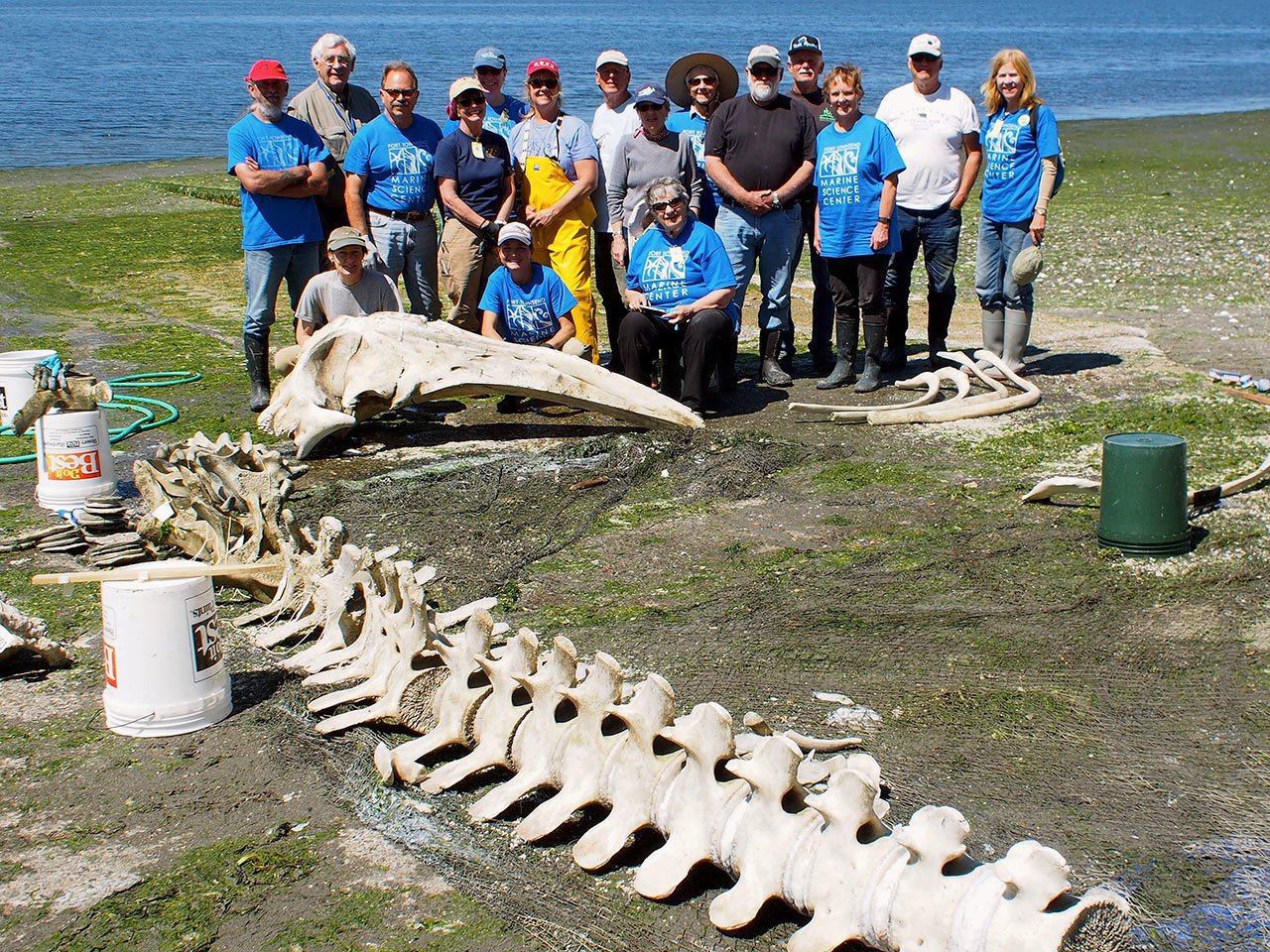PORT TOWNSEND — The bones of a deceased gray whale that was anchored underwater at Naval Magazine Indian Island have been moved to a Marrowstone Island greenhouse to dry and are destined to become a new exhibit at the Port Townsend Marine Science Center.
The baleen from the whale was pulled out of the freezer Monday and is drying on the dock, said Betsy Carlson, citizen science coordinator for the Port Townsend Marine Science Center at 532 Battery Way at Fort Worden. Gray whales lack teeth and instead use baleen to filter water for food.
“Exactly how and where” the bones will be displayed “has not been worked out,” Carlson said.
The bones will be labeled this winter. Articulation — putting them together to be displayed — has not been scheduled. It has yet to be decided if the educational exhibit will be a traveling exhibit or a stationary one, she added.
“We’re still in the process of getting the parts stable so they will be preserved for a long time,” Carlson said.
The gray whale died in May in Elliott Bay near downtown Seattle. The 29-foot long juvenile female gray whale, which weighed between 13,000 and 15,000 pounds, was originally sighted alive in late April in the Puget Sound and was observed having difficulty swimming and diving.
It was between 2 and 4 years old, according to the National Marine Mammal Foundation.
Cascadia Research and the state Department of Natural Resources towed the whale to Indian Island for a necropsy.
Biologists and veterinarians found that the whale suffered from a collapsed lung which filled its chest cavity with air and made the animal too buoyant to dive and feed, according to Phil Guerrero, public affairs specialist with Navy Region Northwest, in a news release.
The lung collapse was probably through an impact with something, Carlson said. Whether that was a boat, another whale or some other object is unknown.
Asked if the marine science center wanted the bones for display, executive director Janine Boire said yes, enthusiastic about adding the display to the center’s collection, according to Carlson.
The center now has an orca skeleton on display.
On May 18, science center volunteers and staff members anchored the gray whale’s body just off shore at Naval Magazine Indian Island.
“The Navy was great about working with us,” Carlson said.
Marine mammal veterinarian Dr. Peter Schroeder of the National Marine Mammal Foundation provided guidance to the team of volunteers and staff.
The whale was wrapped in a fishing net and anchored with boat anchors just off Crane Point on Indian Island.
“At the time of the whale being anchored off shore, NAVMAG was involved in the Cascadia Rising and Joint Logistics Over the Shore exercises,” Guerrero said, adding that buoys were used to mark the location of the whale carcass to warn boaters to avoid the area.
Science center swimmers, including volunteer Howard Teas, used dive suits, snorkels and an underwater GoPro camera and dived on three occasions to document the decomposition of the whale carcass, Guerrero and Carlson said.
The divers saw ample crabs on the body of the whale, according to Sara Street, Indian Island natural resources manager.
“Initially it was thought that the body could take up to two years to decompose naturally. However, within three months very little was left of the whale except for its bones,” Guerrero said.
Said Carlson: “We weren’t sure how long it was going to take. Two to three months is not unexpected in these waters.”
Boire thanked the Navy for its cooperation.
“Working with the Navy staff has been great. Sara [Street] was there for every visit assisting our staff and we very much appreciate the commander’s support of this unexpected and unique operation,” Boire said.
The bones were pulled out beginning Aug. 4 in a two-day process.
“One of our ingenious volunteers, Darryl Hrenko, figured out we could attach 50-gallon plastic barrels to the whale as flotation,” Carlson said.
The plastic barrels were secured at low tide, and at high tide, the science center crew towed the netting and bones to shore where a group of volunteers inventoried, scrubbed and rinsed each bone.
Several organizations were involved in the project along with the marine science center and the Navy.
They include National Oceanic and Atmospheric Administration Fisheries, National Marine Mammal Foundation, Cascadia Research Collective, state Department of Fish and Wildlife, Washington State Parks, state Department of Natural Resources, U.S. Coast Guard, Seal Sitters, Orca Network, Seattle Aquarium, SeaDoc Society and AmeriCorps members.
________
Executive Editor Leah Leach can be reached at 360-417-3530 or at lleach@peninsuladailynews.com.

